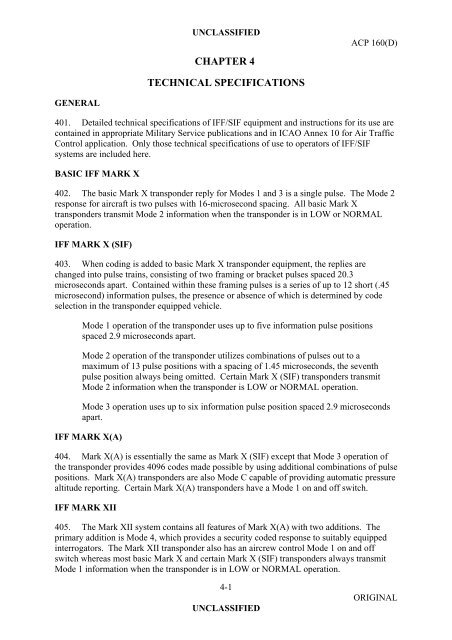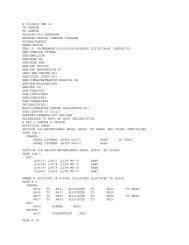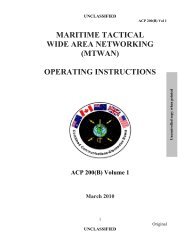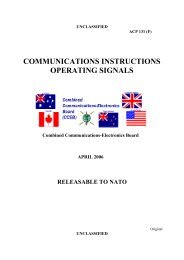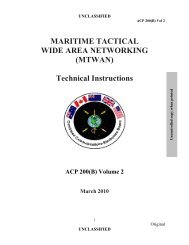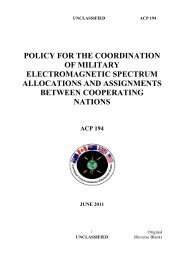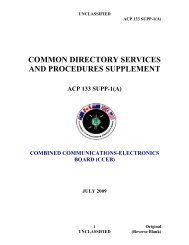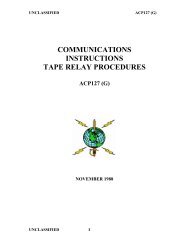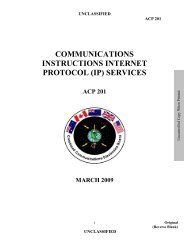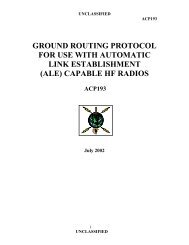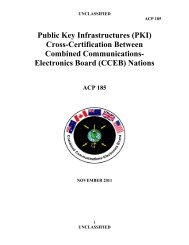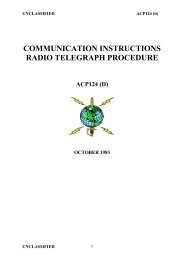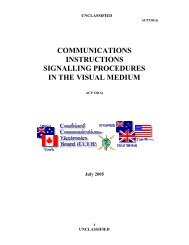IFF/SIF OPERATIONAL PROCEDURES
IFF/SIF OPERATIONAL PROCEDURES
IFF/SIF OPERATIONAL PROCEDURES
You also want an ePaper? Increase the reach of your titles
YUMPU automatically turns print PDFs into web optimized ePapers that Google loves.
GENERAL<br />
UNCLAS<strong>SIF</strong>IED<br />
CHAPTER 4<br />
TECHNICAL SPECIFICATIONS<br />
4-1<br />
UNCLAS<strong>SIF</strong>IED<br />
ACP 160(D)<br />
401. Detailed technical specifications of <strong>IFF</strong>/<strong>SIF</strong> equipment and instructions for its use are<br />
contained in appropriate Military Service publications and in ICAO Annex 10 for Air Traffic<br />
Control application. Only those technical specifications of use to operators of <strong>IFF</strong>/<strong>SIF</strong><br />
systems are included here.<br />
BASIC <strong>IFF</strong> MARK X<br />
402. The basic Mark X transponder reply for Modes 1 and 3 is a single pulse. The Mode 2<br />
response for aircraft is two pulses with 16-microsecond spacing. All basic Mark X<br />
transponders transmit Mode 2 information when the transponder is in LOW or NORMAL<br />
operation.<br />
<strong>IFF</strong> MARK X (<strong>SIF</strong>)<br />
403. When coding is added to basic Mark X transponder equipment, the replies are<br />
changed into pulse trains, consisting of two framing or bracket pulses spaced 20.3<br />
microseconds apart. Contained within these framing pulses is a series of up to 12 short (.45<br />
microsecond) information pulses, the presence or absence of which is determined by code<br />
selection in the transponder equipped vehicle.<br />
Mode 1 operation of the transponder uses up to five information pulse positions<br />
spaced 2.9 microseconds apart.<br />
Mode 2 operation of the transponder utilizes combinations of pulses out to a<br />
maximum of 13 pulse positions with a spacing of 1.45 microseconds, the seventh<br />
pulse position always being omitted. Certain Mark X (<strong>SIF</strong>) transponders transmit<br />
Mode 2 information when the transponder is LOW or NORMAL operation.<br />
Mode 3 operation uses up to six information pulse position spaced 2.9 microseconds<br />
apart.<br />
<strong>IFF</strong> MARK X(A)<br />
404. Mark X(A) is essentially the same as Mark X (<strong>SIF</strong>) except that Mode 3 operation of<br />
the transponder provides 4096 codes made possible by using additional combinations of pulse<br />
positions. Mark X(A) transponders are also Mode C capable of providing automatic pressure<br />
altitude reporting. Certain Mark X(A) transponders have a Mode 1 on and off switch.<br />
<strong>IFF</strong> MARK XII<br />
405. The Mark XII system contains all features of Mark X(A) with two additions. The<br />
primary addition is Mode 4, which provides a security coded response to suitably equipped<br />
interrogators. The Mark XII transponder also has an aircrew control Mode 1 on and off<br />
switch whereas most basic Mark X and certain Mark X (<strong>SIF</strong>) transponders always transmit<br />
Mode 1 information when the transponder is in LOW or NORMAL operation.<br />
ORIGINAL


